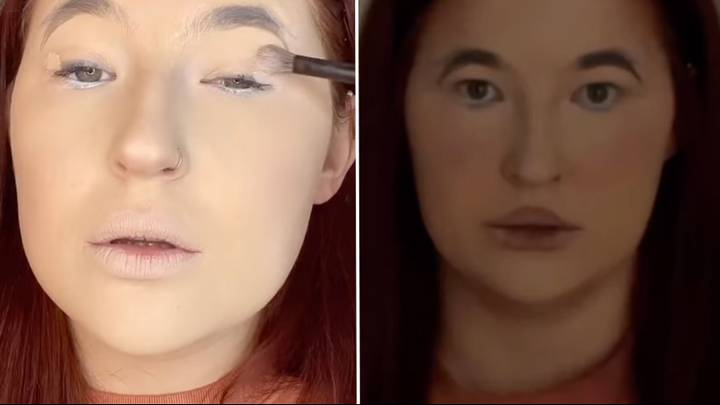What is Uncanny Valley Makeup
Uncanny Valley Makeup refers to a style of makeup that aims to create an unsettling or eerie appearance by emphasizing certain features to the point where they become almost too realistic but still fall short of true human likeness. The term “uncanny valley” originates from robotics and refers to the discomfort or unease people may feel when confronted with a humanoid robot or animated character that looks almost, but not quite, like a real human.
In the context of makeup, artists may use techniques such as hyper-realistic prosthetics, extreme contouring, or exaggerated features to create a look that teeters on the edge of being lifelike but still retains an artificial quality. The goal is often to evoke a sense of unease or fascination in the viewer by blurring the line between reality and illusion. Read about Did Elvis Wear Makeup
Understanding the Concept of the Uncanny Valley
The uncanny valley phenomenon suggests that as a robot or an animated character becomes more human-like in appearance and behavior, there is a point at which it starts to evoke feelings of unease and revulsion in human observers. This dip in likability is known as the “uncanny valley.”
:max_bytes(150000):strip_icc()/cats-646e43c2288c4e6fbbbc712c68956640.jpg)
Evolution of Makeup in Media and Entertainment
Over the years, advancements in makeup technology have led to increasingly realistic portrayals of characters in movies, TV shows, and other forms of media. Makeup artists constantly strive to push the boundaries of creativity while navigating the complexities of the uncanny valley.
Role of Makeup Artists in Bridging the Uncanny Valley
Makeup artists play a crucial role in bridging the uncanny valley by employing their skills to strike the perfect balance between realism and artificiality. Through their expertise in prosthetics, sculpting, and color theory, they bring characters to life while avoiding the pitfalls of the uncanny valley. Discover about What is Makeup Primer
Examples of Uncanny Valley Makeup in Films and TV Shows
Numerous examples abound in the world of cinema and television where uncanny valley makeup has been employed to great effect. From lifelike androids to fantastical creatures, makeup artists have successfully created visually stunning characters that captivate audiences while challenging their perceptions of reality.
Psychological Impact of Uncanny Valley Makeup
The presence of uncanny valley makeup can evoke strong emotional responses in viewers, ranging from fascination to discomfort. Psychologists attribute this reaction to the brain’s innate ability to discern subtle cues of human likeness, which, when distorted, can trigger feelings of unease and mistrust.
Ethical Considerations Surrounding Uncanny Valley Makeup
As the use of uncanny valley makeup becomes more prevalent in media and entertainment, ethical considerations come to the forefront. Questions regarding consent, representation, and the blurring of reality and fiction raise important discussions about the responsibilities of makeup artists and content creators.
The Future of Uncanny Valley Makeup
Despite its challenges and controversies, uncanny valley makeup continues to push the boundaries of creativity and innovation in the fields of makeup artistry and special effects. With ongoing advancements in technology and artistic techniques, the future promises even more groundbreaking creations that blur the line between reality and fantasy.

Conclusion
Uncanny valley makeup represents a fascinating intersection of art, technology, and psychology, offering both creative opportunities and ethical dilemmas for makeup artists and content creators alike. As society grapples with the implications of increasingly realistic portrayals in media and entertainment, the conversation surrounding uncanny valley makeup remains as relevant and complex as ever.
FAQs
- Is uncanny valley makeup only used in movies and TV shows?
- Uncanny valley makeup is predominantly used in film, television, and digital media but can also be found in other creative industries like theater and cosplay.
- How do makeup artists avoid the uncanny valley effect?
- Makeup artists employ various techniques such as subtle prosthetics, strategic lighting, and meticulous attention to detail to create characters that appear realistic without crossing into the realm of the uncanny valley.
- Are there any cultural differences in the perception of uncanny valley makeup?
- Cultural norms and perceptions can influence how people interpret and respond to uncanny valley makeup. What may seem unsettling in one culture could be embraced as artistic expression in another.
- Can uncanny valley makeup be used for purposes other than entertainment?
- While uncanny valley makeup is primarily associated with entertainment media, it has potential applications in fields such as medical simulation, virtual reality, and advertising.
- What are some tips for makeup artists looking to explore uncanny valley makeup?
- Experimentation, attention to detail, and a deep understanding of human anatomy and psychology are key for makeup artists delving into the realm of uncanny valley makeup.
Welcome to Smith’s world, where elegance meets expression, and style is a testament to a peerless life. With an innate passion for style and an unyielding commitment to timeless elegance, Smith curates a space where fashion transcends trends.
